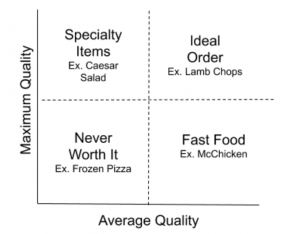Those that have had the honor and privilege of joining me at a restaurant know that I have mastered the exact art and subtle science that is ordering food. While this may seem like a natural affinity, I was born exceptionally indecisive and chronically hangry, and developed this ability in a truly Darwinian fashion, through years of empathy, prototyping, and testing. To start you on your journey to well-balanced, budget friendly superior dining, consider a few of the following tips and tricks:
- Know Your Portions – we’re all familiar with the glory that is sharing food, but in order to make “one for the table” an effective strategy, ask how big a portion is / how many units it contains. At many restaurants, you can get multiple of your party’s size for a small up charge too (i.e. if I’m out to eat with a group for 3 and an appetizer usually comes with 4 pieces, for a small upcharge, we can get 6 pieces, so that everyone gets two. Yay math!).
- Ask the SME – most of the time, waiters have tried the majority of the menu and are familiar with the most and least popular options. Leverage that expertise by asking them (in a kind and thoughtful manner) if you’re missing any restaurant staples or new specials, if the portion sizes will be suitable for your group, etc.
- Keep A Menu – to mitigate the anxiety one often feels in returning the menu after ordering, keep one for the table. This allows you to experience courses of a meal, balance out an impulse order, and stay in tune with prices for future decision making.
- Spin the Specials – happy hour is everyone’s best friend. With a simple google search or phone call, you can easily find out what food and drink specials different restaurants run on different days of the week and at different times. If you’re like me, you’ll create a color coded spreadsheet of these options, organized by region, price point, and “vibe”. If you’re normal, you’ll just commit a few to memory.
- Average vs. Max Quality Index – if you’ve never been to a restaurant and their specialties are not advertised, think about the average quality of that food compared to the maximum possible quality of that food and order accordingly. I like to picture average quality and maximum quality as two axes on a graph, and generally aim to order foods in the top right quadrant of this graph (see below). These dishes are likely to be pretty good (high average quality) and have the ability to be really great (high maximum quality). The top left quadrant – foods that are often mediocre but occasionally stellar – is also an option, but only if you know that food is a specialty of that particular restaurant or region. It’s also important to note foods that require unique ingredients or specialized tools. These “capital intensive” menu items are often relatively high quality, as they require a higher fixed cost from the supplier, and are therefore likely to be a perfected specialty to generate the profit necessary to compensate for that cost. Yes, I was an econ major.

Happy Ordering!

